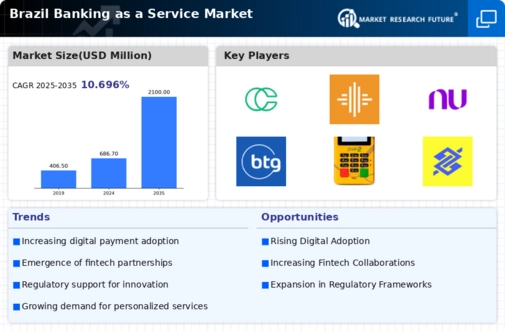The Brazil Banking as a Service Market has shown remarkable growth, driven by the expanding digital economy, increased smartphone penetration, and a shift toward more personalized banking solutions. This market offers third-party organizations the capability to provide their own financial products and services by leveraging the banking infrastructure of traditional financial institutions. The competitive landscape of this market is characterized by a diverse array of players who are vying for market share and customer loyalty by offering innovative products designed to cater to the evolving needs of consumers and businesses alike.
As financial technology continues to disrupt traditional banking, companies are increasingly focusing on user experience, data security, and operational efficiency to enhance their market presence and stay ahead of competitors. Creditas stands out in the Brazil Banking as a Service Market as a key player with a unique value proposition centered on providing secured loans and credit solutions tailored to consumers. The company leverages technology to streamline the loan application process, allowing clients to obtain financing against their assets, such as property or vehicles.
Creditas has built a strong brand presence in Brazil, notably recognized for its customer-centric approach and transparent pricing structure.
The strength of Creditas lies in its ability to combine technology with financial services, ensuring a seamless experience for users by employing key partnerships with banks and other financial institutions. This strategy positions them advantageously in a competitive marketplace, allowing for scalability and adaptability in response to evolving consumer demands. Banco Inter, another significant player in the Brazil Banking as a Service Market, offers a comprehensive suite of financial services that includes digital banking accounts, investment products, and credit solutions.
Known for its first mobile approach, Banco Inter emphasizes user convenience and accessibility, enabling customers to manage their finances entirely through its app. The company has successfully expanded its market presence by acquiring smaller fintech firms, thus broadening its product offerings and enhancing customer engagement.
One of Banco Inter's key strengths is its ability to integrate various services into a single platform, creating a holistic banking experience. Furthermore, the company continually innovates, launching new features like digital credit cards and investment products, which cater specifically to the Brazilian population's needs. This commitment to technological advancement and market responsiveness allows Banco Inter to maintain a competitive edge in the fast-evolving landscape of Banking as a Service in Brazil.




















